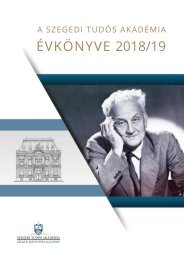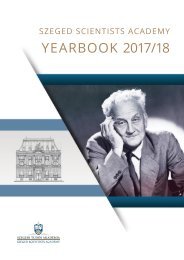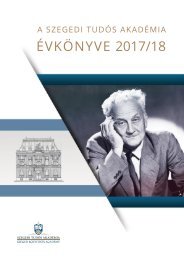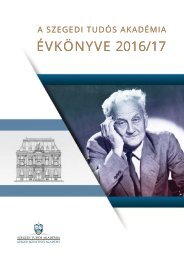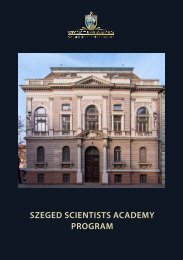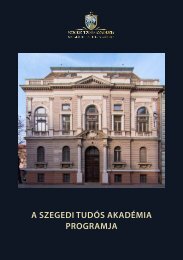SzSA YearBook 2016/17
Create successful ePaper yourself
Turn your PDF publications into a flip-book with our unique Google optimized e-Paper software.
SZENT-GYÖRGYI JUNIOR MENTORS<br />
ROLAND PATAI<br />
Molecular Neurobiology Research Unit<br />
Institute of Biophysics<br />
Biological Research Center of the<br />
Hungarian Academy of Sciences<br />
Address: Temesvári krt. 62., H-6726 Szeged, Hungary<br />
E: patai.roland@brc.mta.hu<br />
T: +36 62/599-600/404<br />
RESEARCH AREA<br />
The saying originating from the US at the beginning of the<br />
previous century “A picture is worth a thousand words” is particularly<br />
adequate for the description of the complexity of<br />
the brain. A new discipline, called geometrical statistics, is<br />
used now by micro-anatomical photography to derive unbiased<br />
data characterizing the number, size, specified surface<br />
portions, etc. of nerve cells by using tiny samples from<br />
an enormously high population (≈ 200 billion) of neurons<br />
constituting the brain.<br />
The results of such investigations either may contribute to<br />
the interpretation of the industrial amount of data coming<br />
from (sometimes) automated molecular biology instruments,<br />
or may substitute those, when variations of biological<br />
functions should be attributed to distributional instead of<br />
quantitative changes in e.g. gene expression. The development<br />
of biological microstructural investigations is undoubtedly<br />
motivated by a typical human desire expressed by “seeing<br />
is believing”. This is most obvious in the regular need of<br />
seeking the structural correlates of the results obtained by<br />
another cutting edge technology, electrophysiology.<br />
Our micro-anatomical research is aimed to derive quantitative<br />
data characterizing nerve cells in healthy conditions,<br />
during disease and ageing, which are also suitable to measure<br />
the effect of treatments aimed to halt or reverse disease<br />
progression.<br />
TECHNIQUES AVAILABLE IN THE LAB<br />
Microsurgical methods to induce acute neurodegeneration<br />
in experimental animals. Basic methods in structural<br />
investigations (light, fluorescent, and electron microscopic<br />
techniques), sample preparation methods for biological<br />
structural research, labeling techniques for molecular imaging<br />
and statistical basis of sampling for unbiased quantitative<br />
microscopy, derivation of biological relevant three-dimensional<br />
parameters from biological tissue, interactive<br />
and automatic computer assisted image analysis, image<br />
analysis programming languages.<br />
SELECTED PUBLICATIONS<br />
Patai, R., Nógrádi, B., Obál, I., Engelhardt, J.I., Siklós, L. (20<strong>17</strong>)<br />
Calcium in the pathomechanism of amyotrophic lateral<br />
sclerosis – taking center stage? Biochem Biophys Res<br />
Comm 483: 1031-1039.<br />
Paizs, M., Patai, R., Engelhardt, J.I., Katarova, Z., Obál, I., Siklós,<br />
L. (<strong>2016</strong>) Axotomy leads to reduced calcium increase and<br />
earlier termination of CCL2 release in spinal motoneurons<br />
with upregulated parvalbumin followed by decreased<br />
neighboring microglial activation. CNS Neur Disord Drug<br />
Targets, in press.<br />
Patai, R., Nógrádi, B., Meszlényi, V., Obál, I., Engelhardt, J.I.,<br />
Siklós, L. (<strong>2016</strong>) Calcium ion is a common denominator in<br />
the pathophysiological processes of amyotrophic lateral<br />
sclerosis. Ideggyogy. Sz., in press.<br />
89







